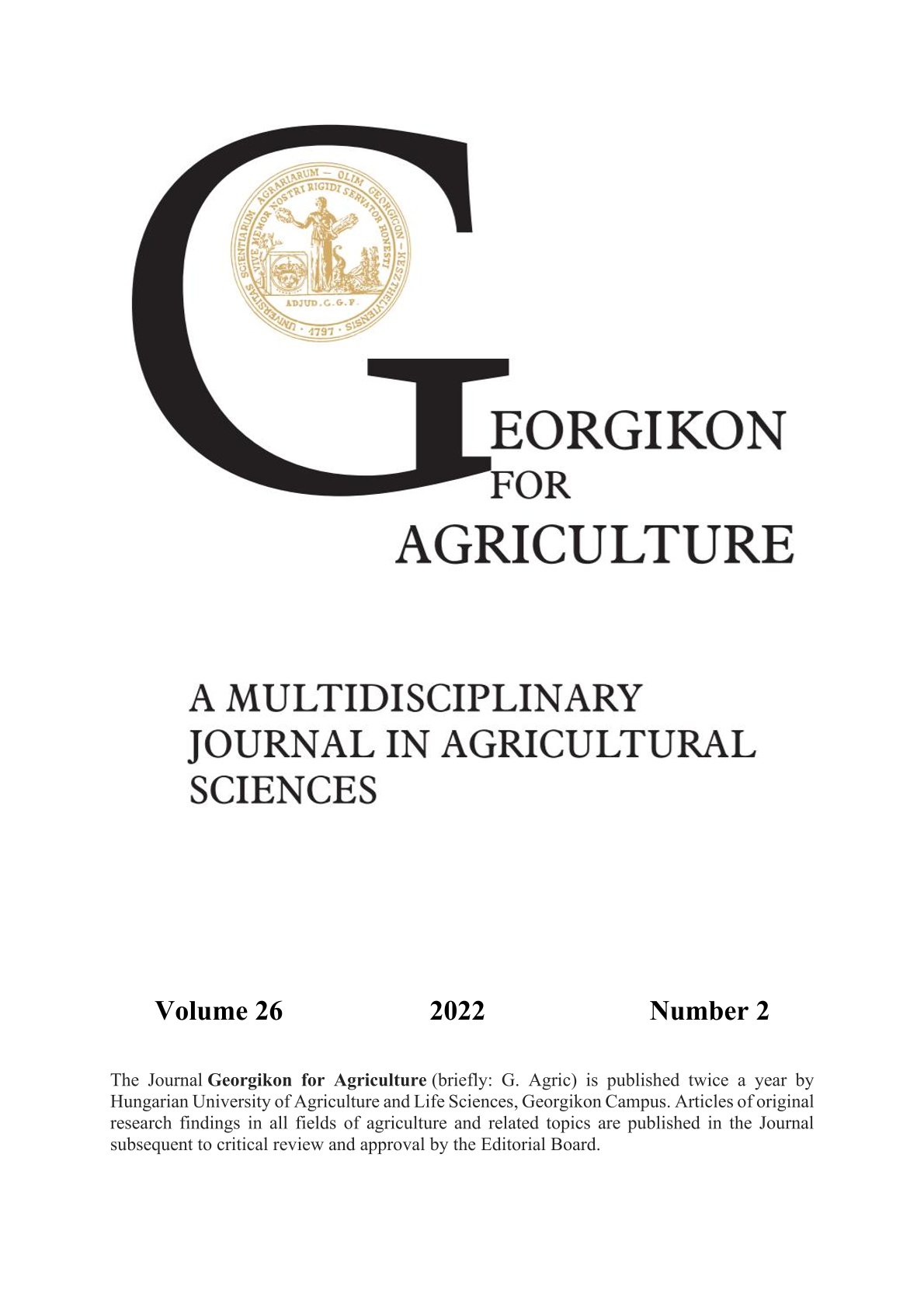Investigation of the relationship between the evaporation and meteorological variables for different Class A pan treatments
Kulcsszavak:
párolgás, párolgásmérő A kád, iszap, hínárAbsztrakt
A párolgás a hidrológiai ciklus kulcsfontosságú tagja. Az éghajlatváltozás következtében a folyamat pontosabb megértése nélkülözhetetlen. A fizikai folyamatok mellett a nyílt víz párolgását biológiai tényezők is befolyásolják (pl. vízi növények jelenléte). A jelenség jobb megértése érdekében egy kísérletet állítottunk be 2020 tenyészidőszakában: a párolgásmérő A kád (WMO) hagyományos alkalmazása mellett az A kádakba üledéket és alámerülten élő, gyökerező hínárnövényeket telepítettünk. Az A kádak a keszthelyi Agrometeorológiai Kutatóállomáson voltak elhelyezve, nyílt területen. Az állomáson a meteorológiai változókat is mértük (levegő hőmérséklete, csapadék, relatív páratartalom, sugárzás, szélsebesség). A vizsgálat célja az iszap és a hínárnövények párolgásra gyakorolt hatásának meghatározása volt. Célkitűzés volt továbbá a párolgás és a meteorológiai változók kapcsolatának vizsgálata is. Az eredmények azt mutatták, hogy mind az üledék, mind a hínárnövények jelenléte fokozta a párolgást. A meteorológiai változók közül a sugárzás és a levegő hőmérséklete mutatta a legszorosabb kapcsolatot a párolgással.
Hivatkozások
Adnan, M.R., Chen, Z., Yuan, X., Kisi, O., El-Shafie, A., Kuriqi, A. and Ikram, M. 2020. Reference Evapotranspiration Modeling Using New Heuristic Methods. Entropy. 22(5). 547. https://doi.org/10.3390/e22050547
Alizamir, M., Kisi, O., Muhammad Adnan, R. and Kuriqi, A. 2020. Modelling reference evapotranspiration by combining neuro-fuzzy and evolutionary strategies. Acta Geophysica. 68. 1113–1126. https://doi.org/10.1007/s11600-020-00446-9
Alsumaiei, A.A. 2020. Utility of artificial neural networks in modeling pan evaporation in hyper-arid climates. Water. 12(5). 1058. https://doi.org/10.3390/w12051508
An, N., Wang, K., Zhou, C. and Pinker, R.T. 2017. Observed variability of cloud frequency and cloud-based height within 3600 m above the surface over the contiguous United States. Journal of Climate. 30. 3725–3742. https://doi.org/10.1175/JCLI-D-16-0559.1
Anda, A. Simon, B., Soós, G., Menyhárt, L., Teixeira, da Silva J.A. and Kucserka, T. 2018a. Extending Class Class A pan evaporation for a shallow lake to simulate the impact of littoral sediment and submerged macrophytes: a case study for Keszthely Bay (Lake Balaton, Hungary). Agricultural and Forest Meteorology. 250-251. 277–289. https://doi.org/10.1016/j.agrformet.2018.01.001
Anda, A. Simon, B., Soós, G. and Kucserka, T. 2018b. Estimation of natural water body’s evaporation based on Class Class A pan measurements in comparison to reference evapotranspiration. Időjárás. 122(1). 41–58. https://doi.org/10.28974/idojaras.2018.1.4
Anda, A., Simon, B., Soos, G., Teixeira da Silva, J.A., and Kucserka, T. 2016. Effect of submerged, freshwater aquatic macrohytes and littoral sediments on pan evaporation in the Lake Balaton region. Hungary. Journal of Hydrology. 542. 615–626. https://doi.org/10.1016/j.jhydrol.2016.09.034
Brezny, O., Mehta, I. and Sharmas, R.K. 1973. Studies of evapotranspiration of some aquatic weeds. Weed Science. 21(3). 197–204. https://doi.org/10.1017/S0043174500032112
Chen, J.L., Yang, H., Lv, M.Q, Xiao, Z.L. and Wu, S.H. 2019. Estimation of monthly pan evaporation using support vector machine in Three Gorges Reservoir Area, China. Theoretical and Applied Climatology. 138(4). 1–13. https://doi.org/10.1007/s00704-019-02871-3
Deo, R. C. and Samui, P. 2017. Forecasting evaporative loss by least-square support-vector regression and evaluation with genetic programming, Gaussian process, and minimax probability machine regression: Case study of Brisbane City. Journal of Hydrologic Engineering. 22(6). 05017003. https://doi.org/10.1061/(ASCE)HE.1943-5584.0001506
Goulden, M.L., Litvak, M., and Miller, S.D. 2007. Factors that control Typha marsh evapotranspiration. Aquatic Botany, 86, 97–106. https://doi.org/10.1016/j.aquabot.2006.09.005
Jiménez-Rodríguez, C.D., Esquivel-Vargas, C., Coenders-Gerrits, M. and Sasa-Marín, M. 2019. Quantification of the Evaporation Rates from Six Types of Wetland Cover in Palo Verde National Park, Costa Rica. Water. 11(4). 674. https://doi.org/10.3390/w11040674
Kim, S., Shiri, J., Singh, V.P., Kisi, O. and Landeras, G. 2015. Predicting daily pan evaporation by soft computing models with limited climatic data. Hydrological Sciences Journal. 60(6). 1120–1136. https://doi.org/10.1080/02626667.2014.945937
Kisi, O. 2015. An innovative method for trend analysis of monthly pan evaporations. Journal of Hydrology. 527. 1123–1129. https://doi.org/10.1016/j.jhydrol.2015.06.009
McVicar, T.R., Roderick, M.L., Donohue, R.J., Tao, Li, L., van Niel, T.G., Thomas, A., Grieser, J., Jhajharia, D., Himri, Y., Mahowald, N.M. and Mescherskaya, A.V. 2012. Global review and synthesis of trends in observed terrestrial near-surface wind speeds: implications for evaporation. Journal of Hydrology. 416–417. 182–205. https://doi.org/10.1016/j.jhydrol.2011.10.024
Pauliukonis, N. and Schneider, R. 2001. Temporal patterns in evapotranspiration from lysimeters with three common wetland plant species in the eastern United States. Aquatic Botany. 71(1). 35–46. https://doi.org/10.1016/S0304-3770(01)00168-1
Sheffield, J., Goteti, G. and Wood, E.F. 2006. Development of a 50-Year High-Resolution Global Dataset of Meteorological Forcings for Land Surface Modeling. Journal of Climate. 19(13). 3088–3111. https://doi.org/10.1175/JCLI3790.1
Wang, L., Niu, Z., Kisi, O., Li, C. and Yu, D. 2017. Pan evaporation modeling using four different heuristic approaches. Computers and Electronics in Agriculture. 140. 203–213. https://doi.org/10.1016/j.compag.2017.05.036
World Meteorological Organization. WMO-No. 8 - Guide to meteorological instruments and methods of observation; 2012, p. I.8-1 to I.9-1.
Letöltések
Megjelent
Folyóirat szám
Rovat
License
Copyright (c) 2022 Simon-Gáspár Brigitta, Soós Gábor, Anda Angéla

This work is licensed under a Creative Commons Attribution-NonCommercial-NoDerivatives 4.0 International License.
The articel is under the Creative Commons 4.0 standard licenc: CC-BY-NC-ND-4.0. Under the following terms: You must give appropriate credit, provide a link to the license, and indicate if changes were made. You may do so in any reasonable manner, but not in any way that suggests the licensor endorses you or your use. You may not use the material for commercial purposes. If you remix, transform, or build upon the material, you may not distribute the modified material. You may not apply legal terms or technological measures that legally restrict others from doing anything the license permits.




 Georgikon for Agriculture
Georgikon for Agriculture